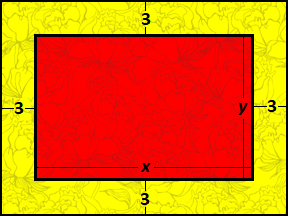Garden Border Problem
A landscaper has been commissioned to plant a rectangular garden of red roses surrounded by a border garden of yellow roses that is 3 feet on each side, as shown below, but in such a way that the area of the red roses is equal to the area of the yellow roses.

He finds one set of integer solutions for the red rose garden to be 30 feet by 9 feet (and by symmetry 9 feet by 30 feet), since both the red rose garden and the yellow rose garden would both have an equal area of 270 square feet. Are there any other integer solutions possible?
This section requires Javascript.
You are seeing this because something didn't load right. We suggest you, (a) try
refreshing the page, (b) enabling javascript if it is disabled on your browser and,
finally, (c)
loading the
non-javascript version of this page
. We're sorry about the hassle.
The red rose garden has an area of x y , and the yellow rose garden has an area of ( x + 6 ) ( y + 6 ) − x y . When both areas are equal, x y = ( x + 6 ) ( y + 6 ) − x y which simplifies to y = x − 6 6 ( x + 6 ) and further to y = 6 + x − 6 7 2 .
Therefore, integer solutions coincide with all the integer divisors of 7 2 (which solves to ( 7 , 7 8 ) , ( 8 , 4 2 ) , ( 9 , 3 0 ) , ( 1 0 , 2 4 ) , ( 1 2 , 1 8 ) , and ( 1 4 , 1 5 ) ) which is a finite set.